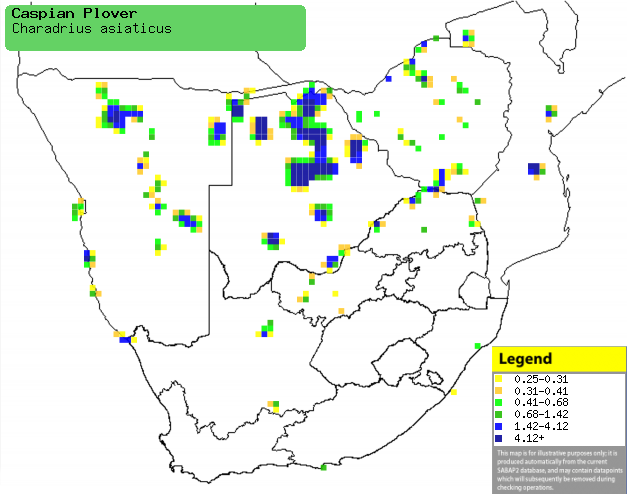|
Charadrius asiaticus (Caspian
plover)
Asiatiese strandkiewiet [Afrikaans]; Kaspische plevier
[Dutch]; Pluvier asiatique [French]; Wermutregenpfeifer [German];
Borrelho-asiático [Portuguese]
Life
> Eukaryotes >
Opisthokonta
> Metazoa (animals) >
Bilateria >
Deuterostomia > Chordata >
Craniata > Vertebrata (vertebrates) > Gnathostomata (jawed
vertebrates) > Teleostomi (teleost fish) > Osteichthyes (bony fish) > Class:
Sarcopterygii (lobe-finned
fish) > Stegocephalia (terrestrial
vertebrates) > Tetrapoda
(four-legged vertebrates) > Reptiliomorpha > Amniota >
Reptilia (reptiles) >
Romeriida > Diapsida > Archosauromorpha > Archosauria >
Dinosauria
(dinosaurs) > Saurischia > Theropoda (bipedal predatory dinosaurs) >
Coelurosauria > Maniraptora > Aves
(birds) >
Order: Charadriiformes > Family: Charadriidae
> Genus: Charadrius
Distribution and habitat
Breeds in central Asia, heading south in the non-breeding
season to eastern sub-Saharan Africa, from Sudan and Ethiopia through Uganda,
Kenya, Tanzania, eastern DRC, Zambia and Angola to southern Africa. Here it is
generally uncommon in central and north-eastern Namibia (including the Caprivi
Strip), patches of Zimbabwe, central Mozambique and northern South Africa, while
most common in northern and central Botswana. It generally prefers dry habitats,
often far from water, such as short grassland, sparsely vegetated plains, salt
pans and ploughed or heavily grazed land.
|
 |
|
Distribution of Caspian plover in southern Africa,
based on statistical smoothing of the records from first SA Bird Atlas
Project (©
Animal Demography unit, University of
Cape Town; smoothing by Birgit Erni and Francesca Little). Colours range
from dark blue (most common) through to yellow (least common).
See here for the latest distribution
from the SABAP2. |
Movements and migrations
Palearctic breeding migrant, leaving its
breeding colonies in August before heading south over land,
beginning to arrive in southern Africa in August, but the main
influx is in the period from September-November. While in the region
it is highly nomadic, eventually departing in late February and
early March.
Food
It mainly eats insects, doing most of its foraging using
the run-stop-search technique typical of plovers, often in short grassland. The following food items have been recorded
in its diet:
Threats
Not threatened, although its global population has
decreased, due to habitat alteration at its breeding grounds.
References
-
Hockey PAR, Dean WRJ and Ryan PG 2005. Roberts
- Birds of southern Africa, VIIth ed. The Trustees of the John Voelcker
Bird Book Fund, Cape Town.
|
